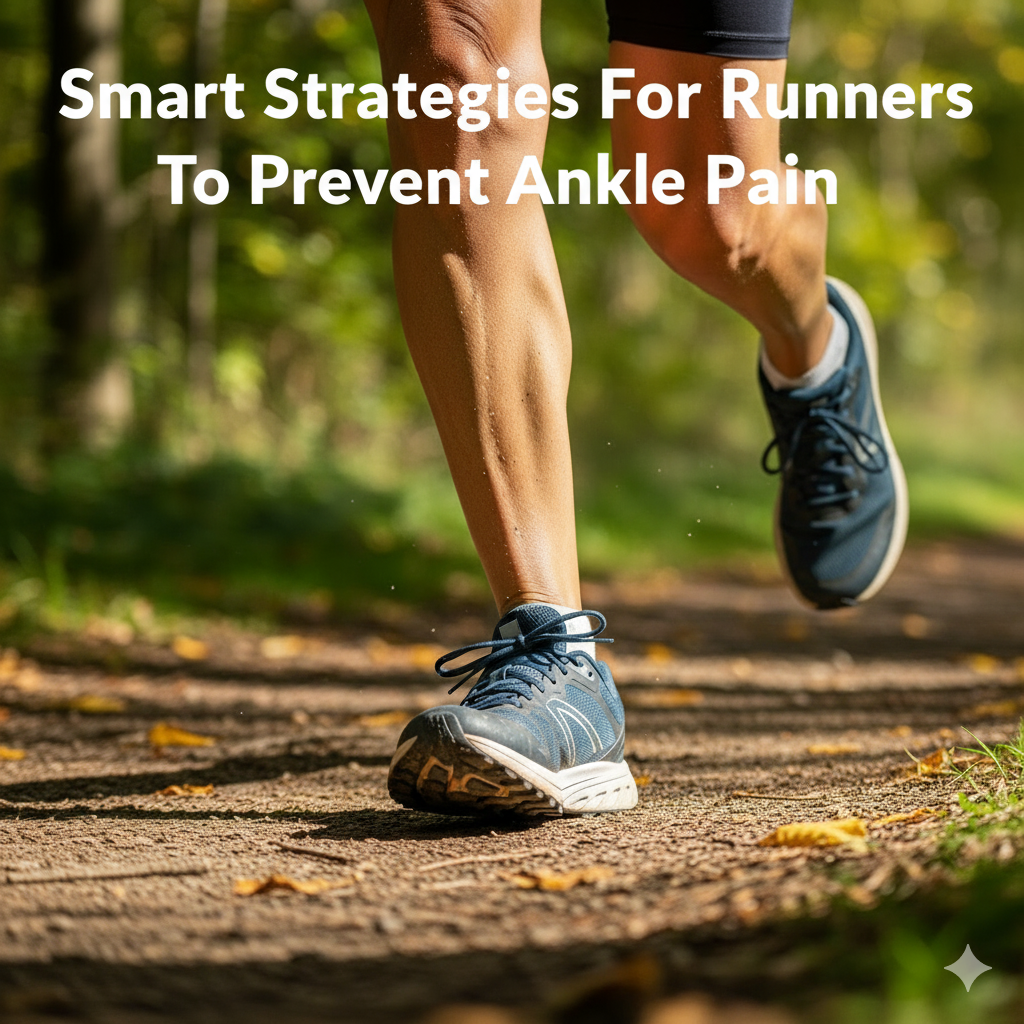- Root Causes of Ankle Pain After 40
- Best Practices to Prevent Ankle Pain After 40
- Prevent Ankle Pain – Final Words:
If you’re still running in your 40s, let me congratulate you! You’re among those few individuals actively breaking the myths around aging and fitness. While many have resigned themselves to the idea that their active days are behind them, you’ve chosen movement, momentum, and mastery. But let’s be honest, running after 40 is a different ballgame. You’re not 25 anymore, and your body, especially your ankles, needs smarter care. So, let’s dive into the strategies that can help you prevent ankle pain and keep your stride strong – step after step.
Ankle pain can become a frustrating hurdle, turning every step into a reminder of vulnerability. A single ankle twist can put you out of action for weeks or months, especially after 40. The good news? You can heal, rehabilitate, and even build stronger ankles than you had in your prime. With the right strategies, you’ll prevent ankle pain, run smarter, stay injury-free, and reclaim the joy of movement. Rest days won’t be forced; they’ll be earned. Age isn’t your limitation. Your approach is.

Root Causes of Ankle Pain After 40
Before we dive into prevention and recovery, it’s important to understand what causes ankle pain in the first place, especially for those over 40. Pain may strike suddenly or build up gradually over time, often due to a combination of wear and tear, postural habits, and biomechanical changes. Here’s a full-spectrum view of what might be contributing to your ankle discomfort:
- Accumulated wear and tear from years of repetitive impact
- Poor posture and gait mechanics
- Biomechanical inconsistencies (e.g., overpronation, limited dorsiflexion)
- Errors in running form (like heel striking or overstriding)
- Scar tissue from old injuries (sprains, fractures, tendon damage)
- Muscle imbalances and weakness in stabilizers
- Tightness in calves, hips, or hamstrings
- Improper footwear or worn-out soles
- Sudden increases in training volume or intensity
- Age-related changes in tendon elasticity and joint lubrication
- Neglected recovery routines and mobility work.
Understanding these root causes empowers you to take smarter action, whether you’re preventing future pain or rehabilitating an existing injury. Strong and stable ankles are a runner’s best friend. They absorb impact, support your stride, and keep you moving with confidence. For runners over 40, protecting your ankles isn’t optional; it’s essential.
Best Practices to Prevent Ankle Pain After 40
Whether you’re just getting back into running or you’re already clocking miles, these strategies will help you protect your ankles and keep moving with confidence.

Warm-Up with Purpose
As we age, muscles stiffen more quickly, increasing the risk of injury. Take a few minutes before each run to perform dynamic stretches, especially targeting your calves, hips, ankles, knees, and surrounding stabilizers. These drills boost circulation, activate key joints, and prepare your body for impact, reducing strain on your ankles from the very first stride.
Maintain a Healthy Body Weight
Extra weight means extra stress on your ankles and joints. With age, metabolism slows down and weight gain becomes easier, but it’s not inevitable. Running helps, but what you eat matters just as much.
- If you’re at a healthy weight, focus on balanced meals to avoid a calorie surplus.
- If you’re overweight, aim for a mild calorie deficit, increase protein, and reduce refined carbs. However, eating less or eating right is not a substitute for regular training.
- Finish your last meal at least 2 hours before bed to avoid storing unused energy.
By maintaining a healthy weight, you reduce joint load and significantly lower your risk of ankle pain or injury, giving your body the support it needs to keep running strong.
Train Your Ankles and Calves
Strong ankles don’t just happen; they’re built. Including ankle and calf exercises in your strength training routine is one of the most effective ways to improve stability and reduce joint impact while running. Here are some targeted exercises that strengthen the muscles and ligaments supporting your ankle joints:
- Calf raises (double and single-leg)
- Heel walks and toe walks
- Ankle circles and plantar flexion drills
- Single-leg balance and balance board exercises
- Standing calf stretch and towel scrunches
- Jump rope for dynamic ankle conditioning
- The Farmer’s walk on toes for endurance and control
- Reverse lunges and box jumps for functional strength
- Ankle dorsiflexion with resistance band
- Banded ankle eversion to target lateral stabilizers
These exercises not only build strength; they enhance proprioception, a key factor in reducing injury risk. Proprioception is your body’s ability to sense its position in space and is crucial for maintaining balance and preventing falls. By improving your proprioception through these exercises, you can reduce the risk of ankle injuries and help your ankles respond better to uneven terrain and repetitive impact.
Listen to Your Body to Prevent Ankle Pain
Ankle pain is a signal and is not something to challenge or ignore. It’s your body’s way of saying: “Something’s not right.” Especially after 40, your body speaks in subtler ways, and dismissing those signals can turn a minor issue into a long-term setback. Discomfort during or after a run might stem from inflammation, instability, or a movement pattern that’s placing excess strain on your joints. The worst thing you can do is override that message with grit alone, without proper assessment.
Here’s how to respond wisely:
- Discomfort during a run? Slow down or stop. Don’t wait for sharp pain to justify your decision.
- Post-run soreness? Use ice, elevate the ankle, and monitor swelling.
- Persistent pain? Don’t guess. Consult a sports medicine specialist or physiotherapist.
- Recurring twinges? Track patterns. Is it terrain-related? Shoe-related? Fatigue-related?
Recovery isn’t passive; it’s proactive and strategic. Pausing your session doesn’t mean you’re giving up. It means you’re giving yourself the chance to keep going stronger tomorrow.
Choose Softer Running Surfaces
A skilled runner can adapt to any terrain with good form and awareness. But if your ankles are injured or consistently painful, it’s time to rethink your surface strategy to support healing. Instead of pounding pavement or concrete, opt for softer surfaces like soil trails, grass tracks, or even beach sand if you’re near the coast. These alternatives absorb more shock and reduce the repetitive impact that aggravates ankle joints.
Treadmill running can also be a smart option, because it eliminates directional changes and allows you to focus fully on maintaining form. If treadmill running also causes discomfort, consider non-impact cardio like elliptical trainers. You’ll still get a solid workout without stressing your ankles. Mixing up your routes can keep things engaging but always stay mindful of where your feet land with each stride. Surface awareness isn’t just about comfort – it’s about longevity.
Invest in the Right Running Shoes to Prevent Ankle Pain
Running shoes are your first line of defense with every foot strike. The right pair can absorb impact, support your stride, and protect your ankles from unnecessary stress. Ideally, your shoes should offer:
- Shock absorption at the heel and forefoot.
- Ankle support for multi-directional movement, even backward strides.
- Breathability to manage heat buildup.
- Moisture-wicking materials to prevent soggy socks and blisters.
- Ergonomic sole design that supports your arch’s natural movement.
- A roomy toe box that allows your toes to spread freely.
- Lightweight construction to improve efficiency and mimic barefoot feel.
Many modern shoes offer extra heel cushioning for added bounce. While this can feel great, it may subtly alter your gait or form. If it works for you and feels natural, go for it. Comfort and biomechanics should guide your choice.
These features become even more important as natural joint shock absorption declines with age. You don’t need the most expensive brand, but you do need the right fit. A little online research can help you find high-quality options at reasonable prices. A proper pair of shoes can make all the difference – preventing ankle pain, improving comfort, and helping you run smarter after 40.
Stay Hydrated All Day
Dehydration can lead to joint stiffness, cramps, and overall discomfort, but hydration isn’t just for post-run recovery or race day. Your body’s cells need consistent fluid intake to function optimally, especially when you’re training regularly after 40.
There’s no one-size-fits-all rule for how much water to drink daily. The idea of a fixed “4 or 5 liters” doesn’t account for individual differences in body composition, metabolism, climate, or activity level. What matters more is tuning into your body’s signals and staying ahead of thirst.
Personal Insight: “I’ve been on both sides of the hydration spectrum. At one point, I was overhydrating, thinking more water meant better recovery. But it disrupted my urination pattern and left me feeling off-balance. That’s when I realized hydration isn’t about volume – it’s about timing, quality, and listening to your body.”
After a run or workout, you’ll naturally need a fluid boost to replenish what you’ve lost through perspiration. Beyond that, hydrate steadily throughout the day based on your personal needs. Remember, hydration also comes from fruits, vegetables, dairy, and smoothies – not just water.
Don’t let the thirst linger. If you feel it, respond. A glass of water, coconut water, or a light smoothie can go a long way in keeping your joints supple and your energy steady.
The Most Important Advice: Protect Your Form
Running in your 40s can be deeply fulfilling, but only if you protect your posture and form. The challenge? You may not even notice when your form starts to slip, especially if you’re compensating for a minor injury or adapting to a new surface.
Personal Insight: “When I switched from asphalt to pavement blocks, I didn’t realize my hamstring engagement was slipping on a few strides. The lack of grip meant my heel wasn’t landing firmly, and while the surface helped me pick up speed, my form was getting compromised. I only noticed it months later when my left hamstring started complaining. Because of my years of running experience, I was able to pinpoint the root cause quickly and have now fully rehabilitated.”
Form breakdowns are often subtle – until they’re not. That’s why it’s essential to stay mindful of your stride pattern, body posture, shoulder alignment, and arm hinge. All the pieces need to fall together smoothly, stride after stride.
Bottom line: Never lose your form, even for a single step, on any surface. If fatigue sets in, just stop or switch to walking. Don’t push through with a limp or lazy posture – that’s a fast track to ankle pain and long-term setbacks. Hold your alignment to the last step. Your body will thank you.
Prevent Ankle Pain – Final Words:
I hope this post helps you prevent ankle pain and enjoy running in your 40s and beyond. Midlife running offers a kind of joy and satisfaction that’s hard to match, and with smart strategies to prevent injury setbacks, you can keep that momentum going for decades.
If you’re dealing with an ankle sprain or recovering from one, you may also want to check out my blog post: “Ankle Sprain and Its Effect on the Other Healthy Leg.” It dives into how compensation patterns can quietly impact your stride and what to do about it.